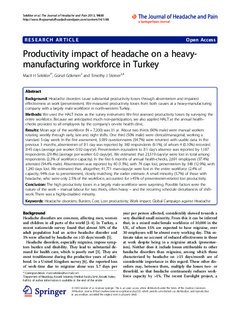| dc.contributor.author | Selekler, Macit H | |
| dc.contributor.author | Gökmen, Gürsel | |
| dc.contributor.author | Steiner, Timothy J. | |
| dc.date.accessioned | 2019-10-29T09:54:55Z | |
| dc.date.available | 2019-10-29T09:54:55Z | |
| dc.date.created | 2014-01-03T16:04:22Z | |
| dc.date.issued | 2013 | |
| dc.identifier.citation | The Journal of Headache and Pain. 2013, 14 (88), . | nb_NO |
| dc.identifier.issn | 1129-2369 | |
| dc.identifier.uri | http://hdl.handle.net/11250/2625061 | |
| dc.description.abstract | Background
Headache disorders cause substantial productivity losses through absenteeism and impaired effectiveness at work (presenteeism). We measured productivity losses from both causes at a heavy-manufacturing company with a largely male workforce in north-western Turkey.
Methods
We used the HALT Index as the survey instrument. We first assessed productivity losses by surveying the entire workforce. Because we anticipated much non-participation, we also applied HALT at the annual health-checks provided to all employees by the company’s on-site health clinic.
Results
Mean age of the workforce (N = 7,200) was 31 yr. About two thirds (90% male) were manual workers rotating weekly through early, late and night shifts. One third (50% male) were clerical/managerial, working a standard 5-day week. In the first assessment, 3,939 questionnaires (54.7%) were returned with usable data. In the previous 3 months, absenteeism of ≥1 day was reported by 360 respondents (9.1%), of whom 4 (0.10%) recorded ≥45 days (average per worker: 0.92 days/yr). Presenteeism equivalent to ≥1 day’s absence was reported by 1,187 respondents (29.4%) (average per worker: 6.0 days/yr). We estimated that 23,519 days/yr were lost in total among respondents (2.3% of workforce capacity). In the first 6 months of annual health-checks, 2,691 employees (37.4%) attended (94.4% male). Absenteeism was reported by 40 (1.5%), with 74 days lost, presenteeism by 348 (12.9%), with 1,240 days lost. We estimated that, altogether, 41,771 man-days/yr were lost in the entire workforce (2.4% of capacity; 94% due to presenteeism), closely matching the earlier estimate. A small minority (5.7%) of those with headache, who were only 2.5% of the workforce, accounted for >45% of presenteeism-related lost productivity.
Conclusion
The high productivity losses in a largely male workforce were surprising. Possible factors were the nature of the work – manual labour for two thirds, often heavy – and the recurring schedule disturbances of shift-work. There was a highly-disabled minority. | nb_NO |
| dc.language.iso | eng | nb_NO |
| dc.publisher | BioMed Central | nb_NO |
| dc.rights | Navngivelse 4.0 Internasjonal | * |
| dc.rights.uri | http://creativecommons.org/licenses/by/4.0/deed.no | * |
| dc.title | Productivity impact of headache on a heavy-manufacturing workforce in Turkey | nb_NO |
| dc.type | Journal article | nb_NO |
| dc.type | Peer reviewed | nb_NO |
| dc.description.version | publishedVersion | nb_NO |
| dc.source.pagenumber | 6 | nb_NO |
| dc.source.volume | 14 | nb_NO |
| dc.source.journal | The Journal of Headache and Pain | nb_NO |
| dc.source.issue | 88 | nb_NO |
| dc.identifier.doi | 10.1186/1129-2377-14-88 | |
| dc.identifier.cristin | 1083658 | |
| dc.description.localcode | Open Access This article is distributed under the terms of the Creative Commons Attribution 2.0 International License (https://creativecommons.org/licenses/by/2.0), which permits unrestricted use, distribution, and reproduction in any medium, provided the original work is properly cited. | nb_NO |
| cristin.unitcode | 194,65,30,0 | |
| cristin.unitname | Institutt for nevromedisin og bevegelsesvitenskap | |
| cristin.ispublished | true | |
| cristin.fulltext | original | |
| cristin.qualitycode | 1 | |

